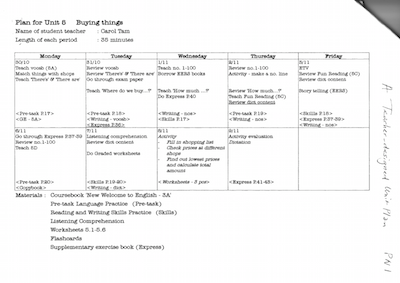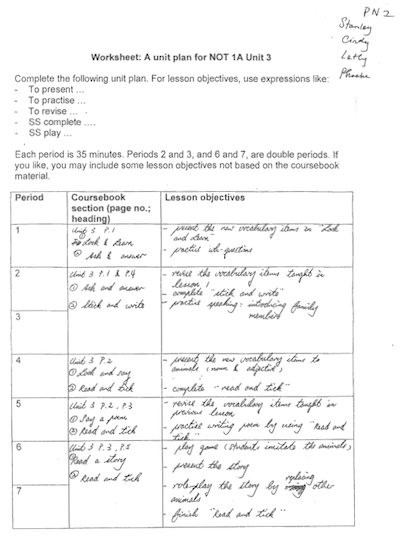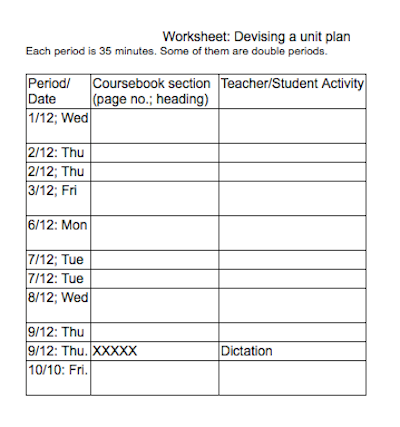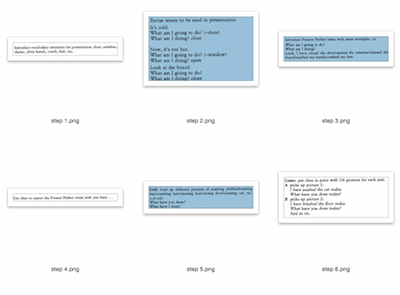Planning for Effective Teaching
Objective: To elucidate the various levels of planning: from official curriculum; to scheme of work; to unit plan; to lesson plan.
Watch the following pre-class video, and then do the quiz. Please note the deadline for completing the pre-class Quiz.
Thinking about the Various Levels of Planning
When we talk about planning for teaching, we are concerned with different levels of planning – from the most macro to the most micro. A few jargon terms are usually used to refer to the products of these levels of planning. Open the following file, and sequence the 4 terms from the most macro to the most micro.
Studying the Relationships between the Scheme of Work and the Coursebook Unit.
The scheme of work is a yearly plan that provides an overview of the yearly programme for the grade level concerned. The scheme of work is usually broken down into units, which usually correspond with the units in the coursebook.
Browse the following documents to get an understanding of the relationships between these levels of planning.
This is a sample scheme of work from the 2004 Primary English Curriculum. It shows how the yearly programme for each grade level may be organized.
This is taken from the TOC of a coursebook. This extract provides an overview of each module and its constituent units.
This is one of the units (i.e., chapters) under the above module plan. It shows the actual content of the unit in question.
From the Official Curriculum to Individual Lesson Plans
The highest level of planning within an education system is the official curriculum. This is usually undertaken by the government department or an official organization entrusted with official curriculum development. In Hong Kong, this work is undertaken by the Curriculum Development Institute (CDI) within the Education Bureau of the Hong Kong Government. The officers concerned are called Curriculum Development Officers.
In the case of Primary English, the latest official curriculum is the one released in 2004.
Most schools in Hong Kong follow an officially approved coursebook. These coursebooks, produced by commercial publishers, have first to be approved by CDI, to ensure that they are following the official curriculum.
At the school level, the English panel chair is responsible for overseeing the development of the school-based English teaching programme, which usually comprises one scheme of work for each grade level. The development of the scheme of work is undertaken by the English panel chair, or shared among the English teachers. This level of planning is done before the start of each academic year.
In practice, most schools derive their schemes of work from the coursebook they have adopted, except for schools that develop their own teaching materials.
The situation may vary, but many schools will take two to three weeks to cover one unit. Although the scheme of work will also provide an overview of each unit, it is not a timetabled plan for the individual teachers teaching the same grade level. In practice, each teacher will need a ‘working unit plan’ which tells her roughly what to do or cover, and on which day, during a unit cycle. This ‘working unit plan’ is an important and useful timetabled guide to teachers.
Once the teacher has this working unit plan, she can then move on to the next level of planning: planning individual lessons.
Finding out more about Unit Plans
Browse the 2 sample unit plans below:
The above is a unit plan actually used by a teacher for one of the unit cycles at her school.
The above unit plan has a different format. It was produced by a small group of student teachers who were practising devising a unit plan from a coursebook chapter.
Devising a Unit Plan
Work in groups of 3, and produce a unit plan. You will be given:
- A unit plan template with timeslots for English;
- A coursebook unit (hard copy)
Study the coursebook chapter given to you. Identify the intended objective of each section of the unit, and estimate the amount of time required for each section. Then draw up a unit plan stating the teacher/learner activity (activities) for each lesson, as follows:
- T (presents, explains, revises, goes through …, etc.), or
- SS (practise, revise, read, answer, do, listen to, ….. etc.)
Consider factors such as (a) how much time you need for each section, (b) need for revision, (c) single lesson vs double lesson, (d) day of the week, (e) time of the lesson, etc. If you wish to change the sequence of the materials, that’s fine.
When you have finished, save your unit plan using the names of the people in your group. Put the file in the folder designated by the tutor.
Getting a Feel for Lesson Planning
In accordance with CLT and TBL, planning a lesson is not about preparing subject matter ideas which are to be conveyed to students through chalk and talk. It is more about setting specific lesson objectives and designing classroom activities that help to achieve those lesson objectives.
The following webpage contains a brief lesson plan and the teaching resources used for a P5 lesson that was designed and delivered by the tutor for a teaching project at a primary school in Tsuen Wan.
Browse through the lesson plan and the teaching resources to get a feel for what lesson planning is like today:
Thinking about Good Instructional Objectives
Good lesson planning always starts with the “end” in mind– What do I want my students to achieve by the end of this lesson?
Today, we would prefer lesson objectives to state learning outcomes which are specific and observable, so that we can gauge how successful a lesson has been. Hence, we often ask a more specific question: What do I want my students to be able to DO by the end of this lesson?
Work in pairs.
Task 1:
Open the following quiz. For each pair of objective statements, decide which one is better.
Task 2:
Open the Matching task below. You will see 6 possible ways to state a lesson objective. Sequence them from the most detailed to the most brief.
Sequencing the Stages of a Lesson
A language lesson typically contains a few stages. The stages form a development that aims to achieve the learning objectives. How the stages should be sequenced depends on a host of factors.
You will see 6 jumbled steps for a lesson on the Present Perfect tense below. Click the photo and sequence them in the best order.
Viewing a Lesson in Action
View a lesson taught by a master teacher, Richard Cauldwell. This lesson took place many years ago, but it illustrates the essence of planning a language lesson – designing useful learning activities and sequencing them coherently with the aim of achieving the learning objectives of the lesson.
While viewing, complete the following lesson observation sheet.








